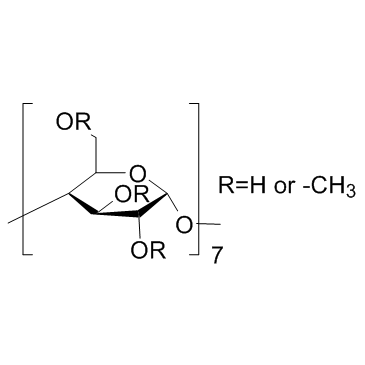128446-36-6
| Name | beta-Cyclodextrin methyl ethers |
|---|---|
| Synonyms |
β-Cyclodextrin methyl ethers
Methyl-Beta-Cyclodextrin Methyl-β-cyclodextrin MFCD00074980 (1S,3R,5R,6R,8R,10R,11R,13R,15R,16R,18R,20R,21R,23R,25R,26R,28R,30R,31S,33R,35R,36R,37S,38R,39S,40R,41S,42R,43S,44R,45S,46R,47S,48R,49S)-5,10,15,20,25,30,35-Heptakis(hydroxymethyl)-37,39,40,41,42,43,4 ;4,45,46,47,48,49-dodecamethoxy-2,4,7,9,12,14,17,19,22,24,27,29,32,34-tetradecaoxaoctacyclo[31.2.2.2.2.2.2.2.2]nonatetracontane-36,38-diol Randomly methylated-β-Cyclodextrin Methyl-beta-cyclodextrin,average Mn ~1310 |
| Description | Methyl-β-cyclodextrin, a cyclic heptasaccharide, is an effective agent for the depletion of cholesterol from cells; also inhibits PEL cell growth with an IC50 of 3.33-4.23 mM. |
|---|---|
| Related Catalog | |
| Target |
IC50: 3.33-4.23 mM (PEL cell growth)[1] |
| In Vitro | Cyclodextrins are a family of cyclic oligosaccharides with a hydrophilic outer surface and a lipophilic central cavity. Cyclodextrins molecules are relatively large with a number of hydrogen donors and acceptors and, thus in general, they do not permeate lipophilic membranes. In the pharmaceutical industry, cyclodextrins have mainly been used as complexing agents to increase aqueous solubility of poorly soluble drugs and to increase their bioavailability and stability. Cyclodextrins are used in pharmaceutical applications for numerous purposes, including improving the bioavailability of drugs[2]. Methyl-β-cyclodextrin quickly induces caspase-dependent apoptosis in PEL cells via cholesterol depletion from the plasma membrane. Methyl-β-cyclodextrin inhibits the growth of all PEL cell lines in a dose-dependent manner. The IC50 is 3.33-4.23 mM in each cell line[1]. Methyl-b-cyclodextrin is a highly water soluble cyclic heptasaccharide consisting of a β-glucopyranose unit, has been reported as the most effective agent for the depletion of cholesterol from cells among the various cholesterol-depleting agents[1]. |
| In Vivo | In a PEL xenograft mouse model, methyl-b-cyclodextrin significantly inhibits the growth and invasion of PEL cells without apparent adverse effects. Methyl-b-cyclodextrin-treated mice appears to be healthy, whereas non-treated mice has a distended abdominal region. The body weights of control are significantly higher than those of M-b-CyD treated mice. Methyl-b-cyclodextrin-treated mice has a significantly lower volume of ascites than that of non-treated mice[1]. Studies in both humans and animals have shown that cyclodextrins can be used to improve drug delivery from almost any type of drug formulation. Currently, there are approximately 30 different pharmaceutical products worldwide containing drug/cyclodextrins complexes in the market[2]. |
| Cell Assay | PEL cells are incubated in triplicate in a 96-well microculture plate in the presence of different concentrations of methyl-β-cyclodextrin (0-10 mM) in a final volume of 0.1 mL for 24 h at 37°C. Subsequently, MTT (0.5 mg/mL final concentration) is added to each well. After 3 h of additional incubation, 100 μL of a 0.04 N HCl is added to dissolve the crystals. Absorption values at 570 nm are determined[1]. |
| Animal Admin | Mice: Female NRJ mice are intraperitoneally inoculated with BCBL-1 cells suspended in PBS. The mice are then treated with intraperitoneal injections of PBS or methyl-β-cyclodextrin (500 mg/kg per day). Tumor burdens are evaluated by measuring body weights and ascites[1]. |
| References |
| Density | 1.4±0.1 g/cm3 |
|---|---|
| Boiling Point | 1206.9±65.0 °C at 760 mmHg |
| Melting Point | 180-182ºC |
| Molecular Formula | C54H94O35 |
| Molecular Weight | 1303.303 |
| Flash Point | 683.7±34.3 °C |
| Exact Mass | 1302.557617 |
| PSA | 422.05000 |
| LogP | 6.95 |
| Vapour Pressure | 0.0±0.6 mmHg at 25°C |
| Index of Refraction | 1.567 |
| Storage condition | 2~8°C |
| Water Solubility | H2O: soluble50mg/mL | Soluble in water |
| Personal Protective Equipment | Eyeshields;Gloves;type N95 (US);type P1 (EN143) respirator filter |
|---|---|
| Hazard Codes | T+ |
| Safety Phrases | S22-S24/25 |
| RIDADR | NONH for all modes of transport |
| WGK Germany | 3 |


